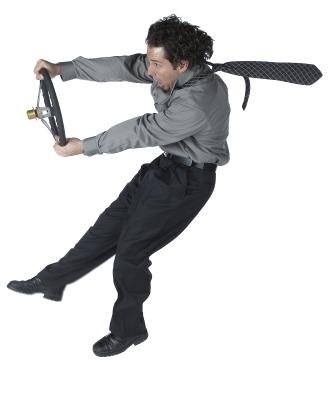
All but the very earliest Ford automobiles use a two-piece steering wheel assembly, which consists of a steering wheel hub and the steering wheel itself. Within the two-piece assembly is the vehicle’s horn switch and, on more modern Fords, an air bag, each electronically controlled. Removing the steering wheel first requires the removal of the hub, and removing the steering wheel itself requires the use of a steering wheel or harmonic balancer puller.
The steering wheel’s hub is the center portion of the steering wheel. Behind the hub is a very large nut, which holds the steering wheel onto the steering column. Because the hub activates the vehicle’s horn, the battery must be disconnected before removing the hub to prevent the horn from blowing and, more importantly, to avoid getting an electrical shock when the steering wheel is removed. The procedure for removing the hub depends on the era the car was build. Older Fords use a twist-on hub, whereby the hub is pressed into a metal bracket and twisted. A large spring then applies pressure from behind the hub and presses the hub against the bracket, thereby holding it in place. To remove this style of hub, press the center of the hub towards the steering column and simultaneously twist the hub in a counterclockwise direction. Take care not to lose the large spring that will now be loose. Modern Fords instead feature a number of screws, typically two, which hold the hub in place from behind the steering wheel. With the screws removed, the hub can be pull away from the steering wheel. Disconnect the wire for the horn and, if so equipped, the wire which leads to the air bag.
In the center of the interior of the steering wheel is a large nut, which must be removed to expose the steering wheel’s mounting stud. Because the steering wheel will still be firmly attached to the steering column, a steering wheel puller is necessary. As an alternative, a harmonic balancer puller may be used. The puller consists of a number of bolts, a long threaded rod and a large metal mounting piece, sometimes called a “duck’s foot.” The bolts slide into the side of the mounting piece, and must be tightened into the threaded holes within the center of the steering wheel. The threaded rod screws through the center of the mounting piece until the base of the rod touches the top of the steering wheel’s mounting stud. The opposite end of the threaded rod is designed to accommodate a wrench. Twist the threaded rod with a wrench in a clockwise direction. The threaded rod will push against the steering wheel’s mounting stud, and the puller will disconnect the steering wheel from the steering column.